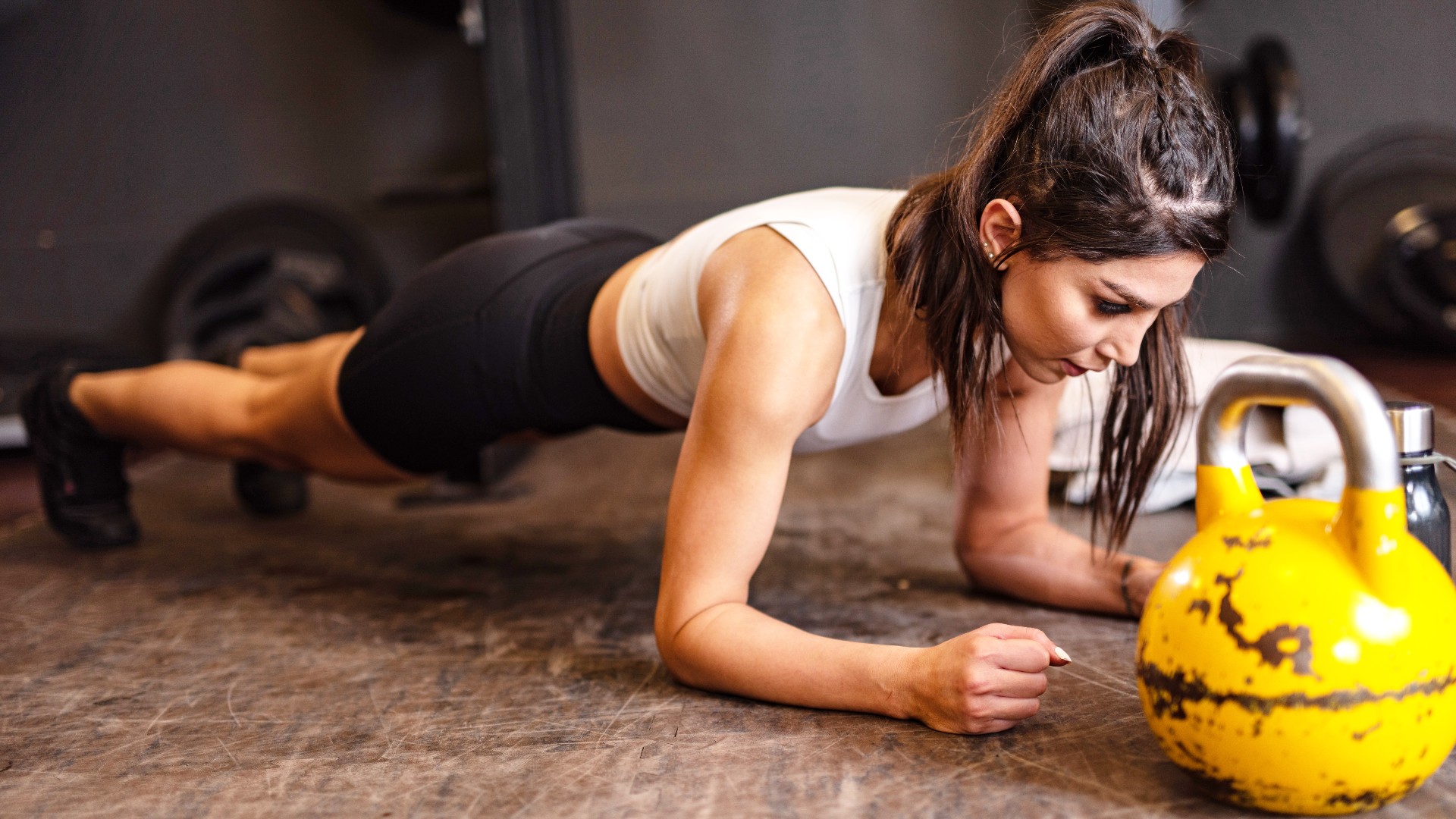
Ah, plank drags. As I ventured into yet another plank challenge, mentally and physically prepared for seven days of sore core muscles, I wondered one thing — why?
It’s a good question. At Tom’s Guide, we’ve now racked up over 19 best plank variations out there, but we’re showing no signs of stopping until the planks run out. Personally, I’m interested in learning more about my body, how it responds to being uncomfortable, challenges, new stimuli — the list goes on.
So, armed with the plank drag, or plank pull-through as it's also known, I recommitted myself to seven more days of core work — 90 reps a day. Here’s what happened to my abs.
How to do plank drags
Grab a weight and learn how to do plank drags with proper form. You could use one of the best adjustable dumbbells, a kettlebell, a plate or a filled water bottle.
How:
- Start in a high plank position and engage your abs, glutes, quads and shoulder muscles.
- Place your weight to the left side of your body, behind your left wrist
- Move your right hand under your body to grip the weight, then drag it over to your right side and place it behind your right wrist
- Repeat the same process, now with your left hand, and keep moving the weight from side to side.
Keep your shoulders stacked over your wrists throughout and avoid letting your hips rise too high, drop too low or twist from side to side — that’s when solid core contraction is crucial to keep the body stable.
I did 90 plank drags every day for a week — here’s what happened to my abs
As always, there’s never just one name for a fitness exercise, so I’ll use the terms plank pull-through and plank drag interchangeably. Whatever you call it, this exercise is a core killer. Here are my results.
Get instant access to breaking news, the hottest reviews, great deals and helpful tips.
Day 1
You might notice people execute plank drags in various ways. If you choose a kettlebell or weight plate, you can drag them across the floor (kettlebells always by the handle, of course). If using a dumbbell, some people pick them up and place them down or drag them by the bar or ends of the dumbbell.
I love kettlebell training, so it was an easy choice. Weight selection made, I worked out how I wanted to complete the 90 reps. On day one, I tried nine sets of 10 with 20 seconds of rest between sets, which wasn’t firing up my stomach enough, so I switched tactics for days two and three.
Days 2 and 3
For the next few days, I focused on EMOM training (every minute on the minute), completing 15 reps within the minute and taking whatever remaining time I had for rest, and starting my next set on the minute.
I did this for six rounds and increased the weight to 10kg. By increasing my reps per set and decreasing rest time, my abs were getting hit considerably harder, and I started working up a sweat by the third or fourth round.
You can tackle plank pull-throughs in two ways: use a lightweight and move faster (cardio focus) or lift heavy and slower (strength focus). For this challenge, I went for the latter and incrementally increased the weight in the last few rounds.

Days 4 and 5
Around halfway, I switched things up again, adding a push-up after every two drags. I also dropped from 15 to 10 reps and increased six to nine rounds.
The plank exercise activates and strengthens most major muscle groups, including the shoulders, arms, core, lower back, glutes and leg muscles. But the pulling or dragging motion helps activate more of your arms, lats, upper back and oblique muscles.
I felt the exercise far more in my waist than usual and had to work harder to keep my position stable when balancing on just one hand to prevent my body from twisting outward. If you’re new to the move, you could try plank pull-throughs on your knees until you feel more comfortable.
You can tackle plank pull-throughs in two ways: use a lightweight and move faster (cardio focus) or lift heavy and slower (strength focus).
Days 6 & 7
The plank pull-through tests endurance, balance, core stability and upper-body strength. It’s also an excellent way to turn a static exercise into an isometric and isotonic contraction. Pulling engages the arms and back, and the move works some muscles through a range of motion while others stay under tension without lengthening or shortening.
Both muscle contractions help build functional strength, but combining them makes the plank more interesting. Besides, learning how to engage your abs during different planes of movement will help you activate your core properly during compound exercises like deadlifts. And with the plank pull-through variation, you can add weights to place muscles under more load.
One of the biggest challenges I faced during this high rep challenge was practicing anti-rotation. Your body naturally wants to shift as you pull, especially your hips, so I focused on keeping my hips square to the mat, grounding through my feet and squeezing my glutes.
As I polished off my final reps, I realized my core was on fire, but my shoulders took much of the heat. I also managed to work my waist much harder than during other plank challenges. However, balancing on one side of the body takes its toll on the shoulders, so I recommend these 5 shoulder stretches after each session to release tension through the arms, chest, upper back and shoulder muscles.
More from Tom's Guide
- I did 50 hip dips a day for a week — here’s the results
- Here's how to do commando planks
- I did 50 windshield wipers every day for a week, here's what happened to my abs.

Sam Hopes is a level 3 qualified trainer, a level 2 Reiki practitioner and fitness editor at Tom's Guide. She is also currently undertaking her Yoga For Athletes training course.
Sam has written for various fitness brands and websites over the years and has experience across brands at Future, such as Live Science, Fit&Well, Coach, and T3.
Having coached at fitness studios like F45 and Virgin Active and personal trained, Sam now primarily teaches outdoor bootcamps, bodyweight, calisthenics and kettlebells.
She also coaches mobility and flexibility classes several times a week and believes that true strength comes from a holistic approach to training your body.
Sam has completed two mixed doubles Hyrox competitions in London and the Netherlands and finished her first doubles attempt in 1:11.

